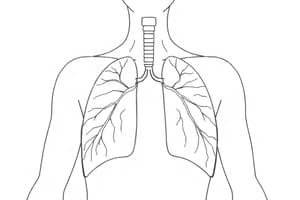Podcast
Questions and Answers
What is the main function of human respiration?
What is the main function of human respiration?
- Producing energy for cells
- Supporting muscle growth
- Creating red blood cells
- Taking in oxygen and expelling carbon dioxide (correct)
During inhalation, what happens to the diaphragm and intercostal muscles?
During inhalation, what happens to the diaphragm and intercostal muscles?
- Diaphragm contracts and intercostal muscles contract (correct)
- Diaphragm relaxes and intercostal muscles contract
- Diaphragm contracts and intercostal muscles relax
- Diaphragm relaxes and intercostal muscles relax
Where does gas exchange primarily occur in the lungs?
Where does gas exchange primarily occur in the lungs?
- Bronchi
- Trachea
- Bronchioles
- Alveoli (correct)
What happens to the volume of the chest cavity during exhalation?
What happens to the volume of the chest cavity during exhalation?
What is the fate of oxygen once it enters the bloodstream?
What is the fate of oxygen once it enters the bloodstream?
What is the main function of human respiration?
What is the main function of human respiration?
Which process in breathing involves the diaphragm moving downward and the intercostal muscles contracting?
Which process in breathing involves the diaphragm moving downward and the intercostal muscles contracting?
What is the role of alveoli in the respiratory system?
What is the role of alveoli in the respiratory system?
Why is it essential to understand respiratory disorders according to the text?
Why is it essential to understand respiratory disorders according to the text?
What is the final product of cellular respiration mentioned in the text?
What is the final product of cellular respiration mentioned in the text?
Flashcards are hidden until you start studying
Study Notes
Human Respiration
Introduction
- Human respiration is the process of taking in oxygen and expelling carbon dioxide, essential for survival.
Mechanism of Breathing
- Breathing involves two main processes: inhalation and exhalation.
- During inhalation:
- Diaphragm contracts and moves downward.
- Intercostal muscles between the ribs contract, causing the rib cage to expand.
- Volume of the chest cavity increases, air pressure in the lungs decreases, and air rushes in.
- During exhalation:
- Diaphragm and intercostal muscles relax.
- Volume of the chest cavity decreases, air pressure in the lungs increases, and air is forced out.
Gas Exchange in the Lungs
- Air enters tiny air sacs called alveoli.
- Oxygen diffuses through the thin walls of the alveoli into the bloodstream, binding to hemoglobin in red blood cells for transport to cells.
- Carbon dioxide, produced by cellular respiration, diffuses from the blood into the alveoli to be exhaled.
Cellular Respiration
- Oxygen is used in cellular respiration to produce energy in the mitochondria of cells.
- Glucose and oxygen react to produce carbon dioxide, water, and energy in the form of ATP (adenosine triphosphate).
Respiratory Disorders
- Various disorders can affect the respiratory system, including:
- Asthma
- Chronic obstructive pulmonary disease (COPD)
- Pneumonia
- Lung cancer
- These disorders can impair gas exchange in the lungs, leading to difficulty breathing and decreased oxygen supply to the body's tissues.
Studying That Suits You
Use AI to generate personalized quizzes and flashcards to suit your learning preferences.




